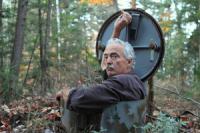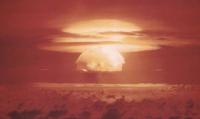-
Preventing nuclear waste seepage
Nuclear waste is a reality, whether remnants of nuclear weapons or the byproducts of nuclear power plants. While we aren’t at risk of an attack from a giant radioactive lizard, nuclear waste can still pose threats to human health. The best way to safely store and contain nuclear waste is by mixing it into a cement grout and storing it in large concrete vaults. Researchers are testing the permeability of these grout mixtures and in turn, the ability for nuclear materials to eventually flow through the solidified grout and into the environment.
-
-
Sandia Labs taking a modern approach to evaluating nuclear weapons
Components of nuclear weapons age, and scientists and engineers address that through life extension programs or less comprehensive alterations. The United States last conducted underground nuclear testing in 1992 and has been in a moratorium ever since. Since then, Sandia Lab has used non-nuclear tests, experiments and computer simulations to study environments weapons might face, such as vibration, radiation or extreme cold or heat.
-
-
Experts: Iran advancing nuclear program with help of North Korea
Iran is using its strategic ties to North Korea to advance its illicit nuclear weapons program, experts say. Nuclear and ballistic missile ties between the two nations are longstanding and ongoing, though unlike Iran, North Korea already has developed nuclear weapons. While Iran is temporarily constrained by the nuclear deal, it can contribute to the development of North Korea’s program by sharing its technology and through finance.
-
-
Trend: Americans building “doomsday bunkers” in large numbers

It may be a fad of the moment, or an indication of a deeper trend, but people across the United States are building and buying “doomsday bunkers” in large numbers. It is not exactly a new business, but demand for underground bunkers is at an all-time high according to industry insiders. A Texas bunker company saw its sales increase 400 percent in the past two months.
-
-
May 2012 North Korean seismic event an earthquake, not nuclear test
A tiny seismic event that occurred in North Korea on 12 May 2010 appears to have been an earthquake rather than a small underground nuclear explosion, according to a new analysis. The new study contradicts the findings of a 2015 report which concluded that the magnitude 1.5 seismic 12 May event was a small nuclear explosion.
-
-
Is Iran cooperating with North Korea on a nuclear weapon?
Spurred by a letter written by Sen. Ted Cruz (R–Texas) to three senior Obama administration officials, investigative journalist Claudia Rosett on Thursday examined the possibility that Iran and North Korea are collaborating on nuclear weapons research in the wake of last year’s nuclear deal. Rosset explained that the two nations have a history of collaborating on weapons development. Usually, North Korea undertakes much of the development while Iran that foots the bill, with technicians traveling back and forth between the countries.
-
-
Expert: Iran falsely accusing U.S. of violating nuclear deal to gain more concessions
Iranian warnings against the passage of the Iran Sanctions Act (ISA) reflect “a broader strategy” in pursuit of additional sanctions relief, a senior analyst at the Foundation for Defense of Democracies, wrote in a policy brief on Saturday. The ISA was originally passed in 1996, targeting Iran’s energy sector and expanding U.S. secondary sanctions. The House of Representatives overwhelmingly approved a ten-year extension of the act earlier this month. In order to be renewed, the legislation must now pass the Senate and be signed into law by President Barack Obama.
-
-
Bathroom air freshener triggers emergency response at nuclear weapons complex
Late in the afternoon on Wednesday of last week officials at the nuclear weapons complex declared an emergency after finding what they regarded as a suspicious device in a bathroom at the Savannah River National Laboratory in South Carolina. Emergency teams determined that the suspicious device was an air freshener wrapped in paper towels with a flashing light on it.
-
-
Canada to investigate object that could be a nuke lost in 1950

The Royal Canadian Navy is to investigate an object found by a diver off the coast of Queen Charolette Islands, suspecting it could be a “lost nuke” which was lost off the coast of Canada since 1950. On 13 February 1950, three of the engines of a U.S. Air Force B-36 bomber aircraft caught fire while flying from Alaska to Texas. The plane was on a training mission, planning to carry out a simulated nuclear attack on San Francisco. The crew decided to drop the bomb into the Pacific Ocean before bailing out because they were unsure of how close they were to populated areas.
-
-
Nuclear CSI: Noninvasive procedure could spot criminal nuclear activity
Determining whether an individual – a terrorist, a smuggler, a criminal — has handled nuclear materials, such as uranium or plutonium, is a challenge national defense agencies currently face. The standard protocol to detect uranium exposure is through a urine sample; however, urine is able only to identify those who have been recently exposed. Scientists have developed a noninvasive procedures that will better identify individuals exposed to uranium within one year.
-
-
Suspension of U.S.-Russia plutonium disposal agreement a setback: Expert
Earlier this week the lower house of the Russian parliament approved President Vladimir Putin’s decree on suspending the U.S.-Russian Plutonium Management and Disposition Agreement (PMDA), which requires each nation to dispose of thirty-four metric tons of plutonium from its dismantled nuclear weapons and military stockpiles. Russia has claimed that the United States is violating the agreement by changing its disposition method from irradiating the plutonium as mixed-oxide (MOX) fuel for commercial nuclear reactors to a process called dilute and dispose, but a nuclear expert says that the United States has not violated the terms of the PMDA by proposing that it change its plutonium disposition approach.
-
-
U.S. could safely reduce the U.S. nuclear arsenal: Critics
Over the last twenty-five years, Russian and U.S. nuclear weapons stockpiles have decreased dramatically. Today the U.S. arsenal stands at around 4,500 warheads, including both deployed and stored weapons. Critics of the U.S. current posture say that the United States could safely reduce its arsenal of deployed strategic nuclear weapons by an additional third from New START levels. They also say that the U.S. strategic and tactical “hedge” — weapons kept in reserve as technical and strategic backups – could be reduced as well.
-
-
Sled track simulates high-speed accident in B61-12 nuclear weapon test
Sandia National Laboratories has sent a mock B61-12 nuclear weapon speeding down the labs’ 10,000-foot rocket sled track to slam nose-first into a steel and concrete wall in a spectacular test that mimicked a high-speed accident. It allowed engineers to examine safety features inside the weapon that prevent inadvertent nuclear detonation. Data analysis from the test continues, and the information will help engineers better understand how systems respond in abnormal environments — accidents or other unexpected events.
-
-
Sled track simulates high-speed accident in B61-12 nuclear weapon test
Sandia National Laboratories has sent a mock B61-12 nuclear weapon speeding down the labs’ 10,000-foot rocket sled track to slam nose-first into a steel and concrete wall in a spectacular test that mimicked a high-speed accident. It allowed engineers to examine safety features inside the weapon that prevent inadvertent nuclear detonation. Data analysis from the test continues, and the information will help engineers better understand how systems respond in abnormal environments — accidents or other unexpected events.
-
-
Terrorism fallout shelters: Is it time to resurrect nuclear civil defense?
Fifty-five years ago, on 6 October 1961, President John F. Kennedy advised Americans to build an underground protective room, commonly known as a “fallout shelter,” in their homes. The American people heeded his advice and began an enormous grassroots effort to construct fallout shelters in every private residence and public building. Today, smaller nations and terrorist groups, such as al-Qaeda, are seeking nuclear weapons. Some nations, like North Korea, already have them. Others may be a decade away. It is not unreasonable to believe that the use of a single nuclear weapon by a rogue nation or a terrorist group now poses a more likely scenario for a nuclear confrontation than a nuclear war between Russia and the United States. We need a strategy to protect ourselves against these adversaries, and right now we don’t have one, except screening cargo. If we don’t find a more effective strategy to thwart nuclear terrorism soon, we may be forced to go back to fallout shelters as our only protective option, whether we like it or not.
-
- All
- Regional
- Water
- Biometrics
- Borders/Immig
- Business
- Cybersecurity
- Detection
- Disasters
- Government
- Infrastructure
- International
- Public health
- Public Safety
- Communication interoperabillity
- Emergency services
- Emergency medical services
- Fire
- First response
- IEDs
- Law Enforcement
- Law Enforcement Technology
- Military technology
- Nonlethal weapons
- Nuclear weapons
- Personal protection equipment
- Police
- Notification /alert systems
- Situational awareness
- Weapons systems
- Sci-Tech
- Sector Reports
- Surveillance
- Transportation
Advertising & Marketing: advertise@newswirepubs.com
Editorial: editor@newswirepubs.com
General: info@newswirepubs.com
2010-2011 © News Wire Publications, LLC News Wire Publications, LLC
220 Old Country Road | Suite 200 | Mineola | New York | 11501
Permissions and Policies
Editorial: editor@newswirepubs.com
General: info@newswirepubs.com
2010-2011 © News Wire Publications, LLC News Wire Publications, LLC
220 Old Country Road | Suite 200 | Mineola | New York | 11501
Permissions and Policies
